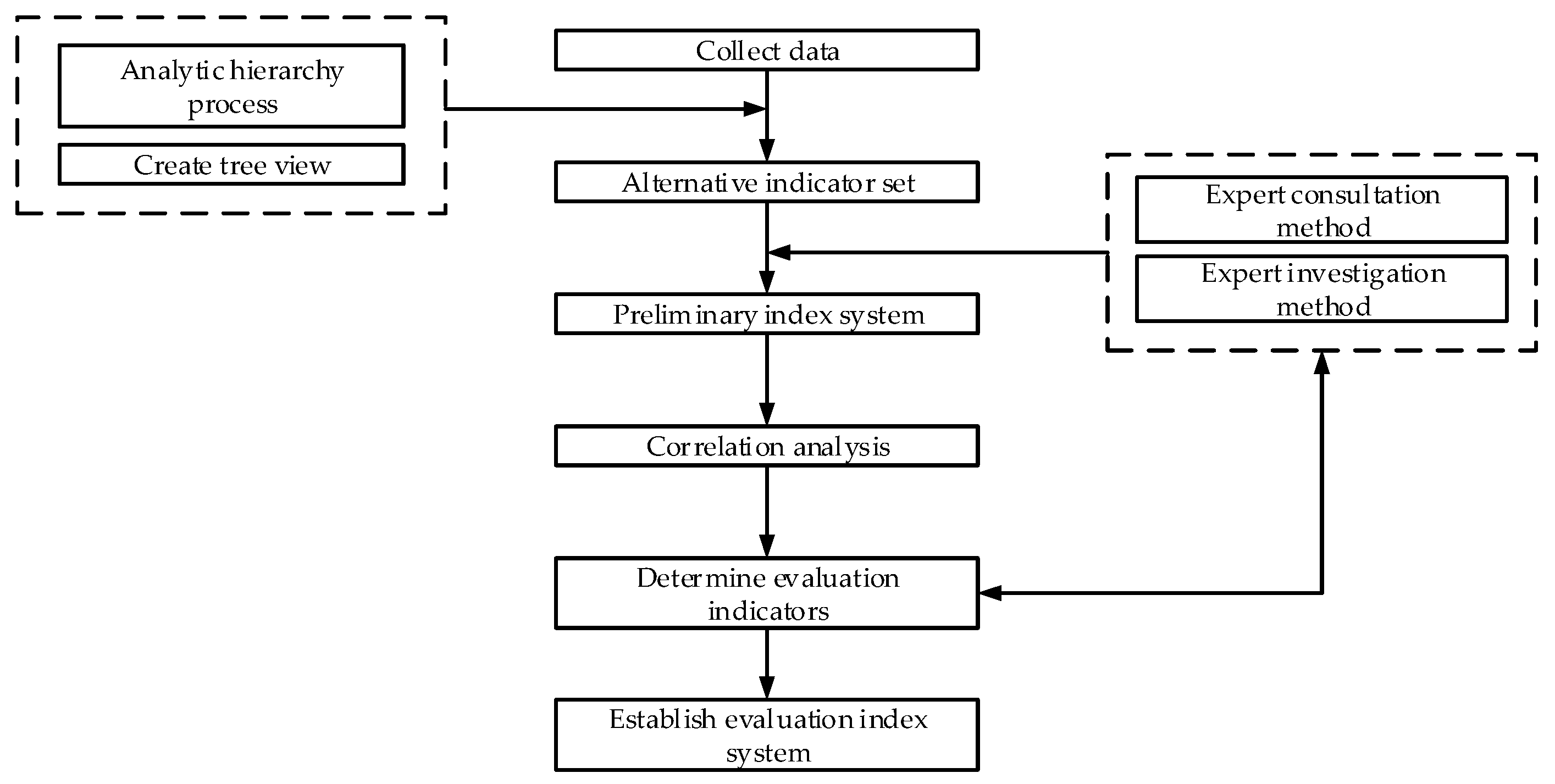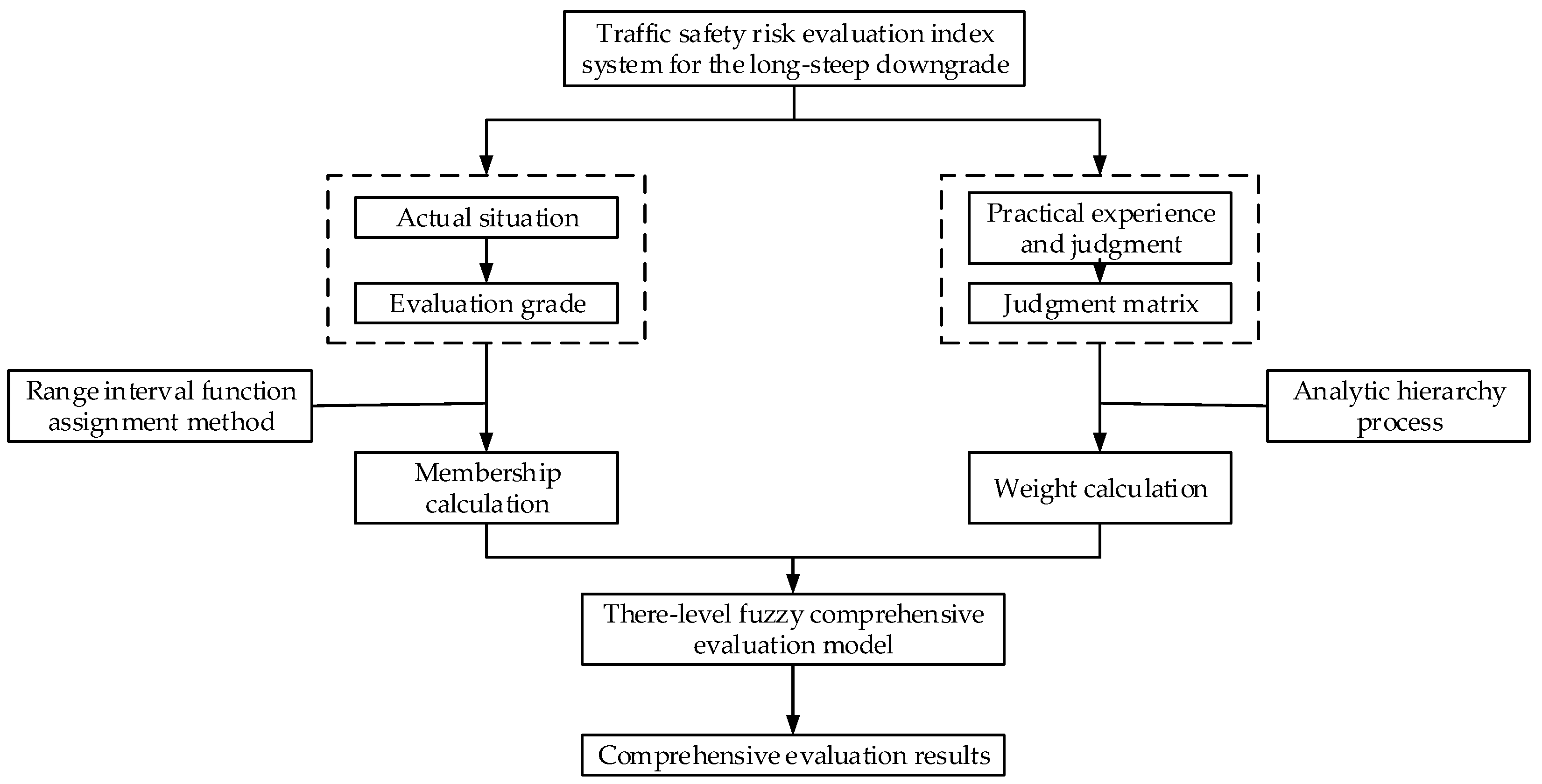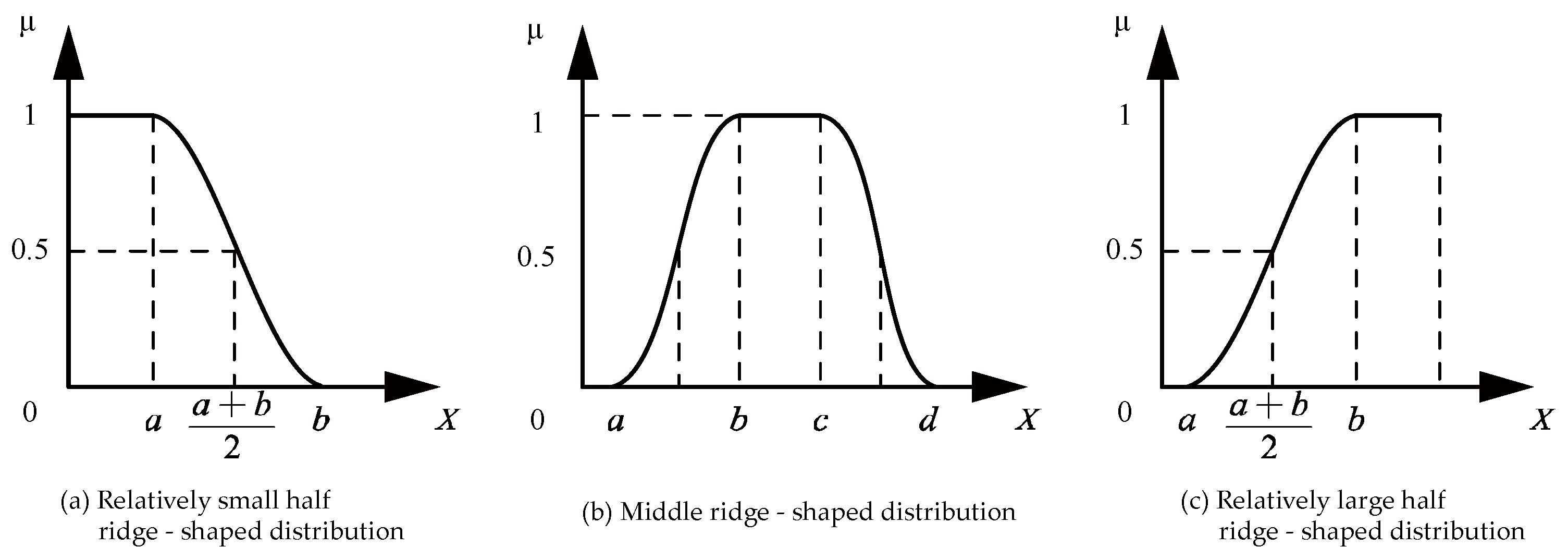Study on Risk of Long-Steep Downgrade Sections of Expressways Based on a Fuzzy Hierarchy Comprehensive Evaluation
Abstract
:1. Introduction
2. Establishment of Evaluation Index System
2.1. Selection Method of Evaluation Indicators
2.2. Construction of Evaluation Index System
- (1)
- Accident Indicators
- (2)
- Hidden Danger Indicators
- Accident indicator A
- Hidden danger indicators
- (1)
- Unsafe road conditions B
- ➀
- Alignment conditions of the road B1
- I.
- Average longitudinal slope and continuous slope length B11
- II.
- Proportion of sharp turns and steep slopes B12
- III.
- Skid resistance of pavement B13
- IV.
- Pavement roughness B14
- V.
- Rationality of extra-large bridges and tunnels B15
- VI.
- Rationality of interchange exit and toll station setting
- ➁
- Active protective facilities B2
- I.
- Completeness of traffic signs B21
- II.
- Completeness of traffic markings B22
- III.
- Rationality of secondary accident early warning facilities B23
- IV.
- Rationality of speed control and monitoring facilities B24
- V.
- Rationality of sight guidance and lighting facilities B25
- ➂
- Passive protection facilities B3
- I.
- Performance of crash barriers B31
- II.
- Rationality of setting truck escape ramps
- III.
- Rationality of other protective facilities B33
- (2)
- Adverse environment C
- ➀
- Service level C1
- ➁
- Proportion of large trucks C2
- ➂
- Running speed of large trucks C3
- (3)
- Management defects D
- ➀
- Speed management D1
- ➁
- Overload D2
- ➂
- Completeness of emergency rescue system D3
2.3. Construction of Evaluation Index Systems
- (1)
- The nondimensionalization of qualitative indicators
- (2)
- The nondimensionalization of quantitative indicators
- ➀
- The “smaller the higher the risk” indicator’s standard function of nondimensionalization ()
- ➁
- The “larger the higher the risk” indicator’s standard function of nondimensionalization ()
- ➂
- The “higher the risk of the attribute value in a certain range” indicator’s standard function of nondimensionalization ()
3. Evaluation Method for the Long-Steep Downgrade Sections Based on the Fuzzy Hierarchical Comprehensive Evaluation
3.1. Construction of Membership Function of Fuzzy Evaluation Grades
3.2. Determination of Evaluation Indicator Weights
3.3. Three-Level Fuzzy Comprehensive Evaluation Model
3.3.1. First-Level Fuzzy Evaluation Operation
3.3.2. Second-Level Fuzzy Evaluation Operations
3.3.3. Third-Level Fuzzy Evaluation Operation
3.4. Analysis of Fuzzy Evaluation Results
4. Engineering Case Analysis
4.1. Establish Evaluation Space
4.2. Evaluation Rank Membership Calculation of Evaluation Indicators
4.3. Weight Calculations of Evaluation Indicators
4.4. Comprehensive Evaluation of Traffic Safety Risks
- ➀
- The first-level fuzzy comprehensive evaluation matrix is:
- ➁
- The second-level fuzzy comprehensive evaluation matrix is:
- ➂
- The third-level fuzzy comprehensive evaluation matrix is:
5. Conclusions
Author Contributions
Funding
Institutional Review Board Statement
Informed Consent Statement
Data Availability Statement
Conflicts of Interest
References
- Tao, W.; Aghaabbasi, M.; Ali, M.; Almaliki, A.H.; Zainol, R.; Almaliki, A.A.; Hussein, E.E. An Advanced Machine Learning Approach to Predicting Pedestrian Fatality Caused by Road Crashes: A Step toward Sustainable Pedestrian Safety. Sustainability 2022, 14, 2436. [Google Scholar] [CrossRef]
- Gnjatović, M.; Košanin, I.; Maček, N.; Joksimović, D. Clustering of Road Traffic Accidents as a Gestalt Problem. Appl. Sci. 2022, 12, 4543. [Google Scholar] [CrossRef]
- Malin, F.; Norros, I.; Innamaa, S. Accident risk of road and weather conditions on different road types. Accid. Anal. Prev. 2019, 122, 181–188. [Google Scholar] [CrossRef]
- Azimi, G.; Rahimi, A.; Asgari, H.; Jin, X. Severity analysis for large truck rollover crashes using a random parameter ordered logit model. Accid. Anal. Prev. 2020, 135, 105355. [Google Scholar] [CrossRef]
- Wu, Y.; Abdel-Aty, M.; Lee, J. Crash risk analysis during fog conditions using real-time traffic data. Accid. Anal. Prev. 2018, 114, 4–11. [Google Scholar] [CrossRef] [PubMed]
- Klauer, S.G.; Guo, F.; Simons-Morton, B.; Ouimet, M.C.; Lee, S.E.; Dingus, T.A. Distracted Driving and Risk of Road Crashes among Novice and Experienced Drivers. N. Engl. J. Med. 2014, 370, 54–59. [Google Scholar] [CrossRef] [Green Version]
- Korkut, M.; Ishak, S.; Wolshon, B. Freeway Truck Lane Restriction and Differential Speed Limits Crash Analysis and Traffic Characteristics. Transp. Res. Rec. J. Transp. Res. Board 2010, 2194, 11–20. [Google Scholar] [CrossRef]
- Kristensen, K.; Kristensen, C.B.; Harbitz, A. {Road Traffic and Avalanches—Methods for Risk Evaluation and Risk Management. Surv. Geophys. 2003, 24, 603–616. [Google Scholar] [CrossRef]
- Hermans, E.; Ruan, D.; Brijs, T.; Wets, G.; Vanhoof, K. Road safety risk evaluation by means of ordered weighted averaging operators and expert Knowledge. Knowl. Based Syst. 2010, 23, 48–52. [Google Scholar] [CrossRef] [Green Version]
- Chen, F.; Peng, H.; Ma, X.; Liang, J.; Hao, W.; Pan, X. Examining the safety of trucks under crosswind at bridge-tunnel section: A driving simulator study. Tunn. Undergr. Space Technol. 2019, 92, 103034. [Google Scholar] [CrossRef]
- Zeng, Q.; Gu, W.; Zhang, X.; Wen, H.; Lee, J.; Hao, W. Analyzing freeway crash severity using a Bayesian spatial generalized ordered logit model with conditional autoregressive priors. Accid. Anal. Prev. 2019, 127, 87–95. [Google Scholar] [CrossRef] [PubMed]
- Yu, R.; Quddus, M.; Wang, X.; Yang, K. Impact of data aggregation approaches on the relationships between operating speed and traffic safety. Accid. Anal. Prev. 2019, 120, 304–310. [Google Scholar] [CrossRef] [PubMed] [Green Version]
- Zheng, L.; Sayed, T.; Essa, M. Validating the bivariate extreme value modeling approach for road safety estimation with different traffic conflict indicators. Accid. Anal. Prev. 2019, 123, 314–323. [Google Scholar] [CrossRef] [PubMed]
- Guo, Y.; Li, Z.; Liu, P.; Wu, Y. Modeling correlation and heterogeneity in crash rates by collision types using full Bayesian random parameters multivariate Tobit model. Accid. Anal. Prev. 2019, 128, 164–174. [Google Scholar] [CrossRef]
- Rajak, M.; Shaw, K.; Rajak, M.; Shaw, K. Evaluation and selection of mobile health (mHealth) applications using AHP and fuzzy TOPSIS. Technol. Soc. 2019, 59, 101186. [Google Scholar] [CrossRef]
- Dai, X.; Wu, Z. Pre-warning system of maritime traffic safety risk in restricted visibility weather. J. Traffic Transp. Eng. 2018, 18, 195. [Google Scholar] [CrossRef]
- Jiang, G. Fuzzy AHP Synthetical Appraise Method and Application. Master’s Thesis, Tianjin University, Tianjin, China, 2005. [Google Scholar] [CrossRef]
- Chen, W.; Zhao, X.; Zhang, H.; Liu, T.; Li, C.; Wang, K. Hazard Assessment of Highway Debris based on the Fuzzy Comprehensive Evaluation Method in Northwest Yunnan. Highway 2020, 2, 25–28. [Google Scholar]
- Gu, M.; Deng, Z.; Tang, Z. Quantitative Evaluation of Complete Streets Based on Fuzzy Comprehensive Analytic Hierarchy Process. Highway 2020, 9, 226–230. [Google Scholar]
- Zhang, J. Evaluation of Inner Mongolia Expressway Operation Management Level. Master’s Thesis, Chang’an University, Xi’an, China, 2019. [Google Scholar] [CrossRef]
- Zhang, S.; Xing, Y.; Lu, J.; Zhang, H.M. Exploring the Influence of Truck Proportion on Freeway Traffic Safety Using Adaptive Network-Based Fuzzy Inference System. J. Adv. Transp. 2019, 2019, 3879385. [Google Scholar] [CrossRef]
- Jiang, H.; Sun, J.; Yang, W.; Zhu, S.; Wang, K. Risk evaluation of higway construction plan based on AHP and improved TOPSIS weight algorithm. Eng. J. Wuhan Univ. 2020, 8, 698. [Google Scholar] [CrossRef]
- Ye, F.; Li, W.; Han, X.; Liu, J.; Ouyang, A.; Xu, C. Investigation of Comprehensive Evaluation System for the Highway Tunnel Portal Design Based on the Combination of Dynamics and Statics. China J. Highw. Transp. 2020, 34, 125–135. [Google Scholar] [CrossRef]
- Saaty, T.L. Decision making with the analytic hierarchy process. Int. J. Serv. Sci. 2008, 1, 83–98. [Google Scholar] [CrossRef] [Green Version]
- Zhu, J. Research on Some Problems of the Analytic Hierarchy Process and Its Application. Ph.D. Thesis, North-Eastern University, Shenyang, China, 2005. [Google Scholar]
- Zhou, F. Establish of Route Selection Index System for Green Highway Based on Sustainable Development Concept. Highway 2018, 63, 106–110. [Google Scholar]





| Evaluation Basis | Score |
|---|---|
| V85 < Actual speed limit of trucks | [0, 20] |
| V85 exceeding the actual speed limit of trucks by 10% | [20, 40] |
| V85 exceeding the actual speed limit of trucks by 20% but less than 50% | [40, 80] |
| V85 exceeding the actual speed limit of trucks by 50% | [80, 100] |
| Qualitative Indicators | Category | Scoring Criteria | ||||
|---|---|---|---|---|---|---|
| [0, 20) | [20, 40) | [40, 60) | [60, 80) | [80, 100] | ||
| Average longitudinal slope and continuous slope length | Degree of safety | safety | Relatively safety | Generally safety | Relatively dangerous | dangerous |
| Rationality of interchange and toll station | Degree of rationality | Reasonable | Relatively reasonable | Generally reasonable | Relatively unreasonable | Unreasonable |
| Completeness of traffic signs | Degree of completeness | Complete | Relatively complete | Generally complete | Relatively incomplete | Incomplete |
| Completeness of traffic markings | Degree of completeness | Complete | Relatively complete | Generally complete | Relatively incomplete | Incomplete |
| Rationality of secondary accident early warning facilities | Degree of rationality | Reasonable | Relatively reasonable | Generally reasonable | Relatively unreasonable | Unreasonable |
| Rationality of speed control and monitoring facilities | Degree of rationality | Reasonable | Relatively reasonable | Generally reasonable | Relatively unreasonable | Unreasonable |
| Rationality of sight guidance and lighting facilities | Degree of rationality | Reasonable | Relatively reasonable | Generally reasonable | Relatively unreasonable | Unreasonable |
| Performance of crash barrier | Degree of intensity | Sufficient | Relatively sufficient | Generally sufficient | Relatively insufficient | Insufficient |
| Rationality of setting of Truck Escape Ramp | Degree of rationality | Reasonable | Relatively reasonable | Generally reasonable | Relatively unreasonable | Unreasonable |
| Rationality of other protective facilities | Degree of rationality | Reasonable | Relatively reasonable | Generally reasonable | Relatively unreasonable | Unreasonable |
| Running speed of truck | Degree of security | Safety | Relatively safety | Generally safety | Relatively dangerous | dangerous |
| Perfection of emergency rescue system | Degree of perfection | Perfect | Relatively perfect | Generally perfect | Relatively imperfect | Imperfect |
| Symbol | v1 | v2 | v3 | v4 | v5 |
|---|---|---|---|---|---|
| Evaluation level | I | II | III | IV | V |
| Risk level | Minimum risk | Lower risk | Medium risk | High risk | Maximum risk |
| Risk assessment | Desired | Acceptable | Acceptable under certain conditions | Undesired | Unacceptable |
| Score interval | [0, 20] | (20, 40] | (40, 60] | (60, 80] | (80, 100] |
| Serial Number | Classification | Situation Description |
|---|---|---|
| 1 | Average longitudinal slope and continuous slope length | The average longitudinal slope is 2.92%, and the continuous downhill slope is 9 km. |
| 2 | Qingkou interchange exit | Located at K1864 + 600 in front of the slope. |
| 3 | Traffic signs | Speed limit signs, direction signs, warning signs of dangerous sections, etc. are set, but warning signs such as those indicating a continuous downhill slope are not set, and some signs do not meet the specification requirements, so the visibility is poor. |
| 4 | Traffic markings | There are white deceleration oscillation markings and red deceleration markings on the road section, but some of the deceleration markings have been worn out. |
| 5 | Secondary accident warning facilities | There are two harbor-style emergency parking belts, but they cannot meet the parking needs of large-scale faulty vehicles; there are three variable information boards, but only one is still in use, and it only reminds of the embargo period for dangerous chemicals. |
| 6 | Speed control facilities | There are area speed measuring facilities, but some vehicles are still speeding. |
| 7 | Monitoring facilities | No monitoring facilities are set up. |
| 8 | Sight guidance | There are attached linear guidance signs on the left side of some sharp curves and triangular outline marks on the right side of most road sections. Reflective films are also attached to the pillars of the guardrail and the anti-glare board, but the linear guidance effect is not good. |
| 9 | Lighting facilities | Not set. |
| 10 | Crash barrier | There is a central divider on the left side of the route and an F-type SAm concrete guardrail; the right side of the route is mainly a cutting-type roadbed with a cover plate side ditch, and there is basically no crash barrier except for the bridge section. |
| 11 | Truck escape ramp | There are three installations, and the installation positions are basically reasonable, but one is located on the inside of the dark bend, which is difficult to identify, the outflow angle is too large, and the entrance warning sign is missing; another entrance is blocked and difficult to identify, and the warning sign does not meet the requirements |
| 12 | Other protective facilities | The roadside side ditch is provided with a cover plate |
| First-Level Rule Level | W | Second-Level Index Level | Wi | Third-Level Index Level | wi |
|---|---|---|---|---|---|
| A | 0.2995 | A1 | 1 | / | / |
| B | 0.5088 | B1 | 0.7306 | B11 | 0.4643 |
| B12 | 0.1472 | ||||
| B13 | 0.2283 | ||||
| B14 | 0.0365 | ||||
| B15 | 0.0717 | ||||
| B16 | 0.0519 | ||||
| B2 | 0.1884 | B21 | 0.2323 | ||
| B22 | 0.0646 | ||||
| B23 | 0.3960 | ||||
| B24 | 0.1826 | ||||
| B25 | 0.1246 | ||||
| B3 | 0.0810 | B31 | 0.4353 | ||
| B32 | 0.4869 | ||||
| B32 | 0.0778 | ||||
| C | 0.1156 | C1 | 0.1172 | / | / |
| C2 | 0.2684 | / | / | ||
| C3 | 0.6144 | / | / | ||
| D | 0.0761 | D1 | 0.2583 | / | / |
| D2 | 0.6370 | / | / | ||
| D3 | 0.1047 | / | / |
Publisher’s Note: MDPI stays neutral with regard to jurisdictional claims in published maps and institutional affiliations. |
© 2022 by the authors. Licensee MDPI, Basel, Switzerland. This article is an open access article distributed under the terms and conditions of the Creative Commons Attribution (CC BY) license (https://creativecommons.org/licenses/by/4.0/).
Share and Cite
Zhao, Y.; Li, J.; Ying, X. Study on Risk of Long-Steep Downgrade Sections of Expressways Based on a Fuzzy Hierarchy Comprehensive Evaluation. Appl. Sci. 2022, 12, 5924. https://doi.org/10.3390/app12125924
Zhao Y, Li J, Ying X. Study on Risk of Long-Steep Downgrade Sections of Expressways Based on a Fuzzy Hierarchy Comprehensive Evaluation. Applied Sciences. 2022; 12(12):5924. https://doi.org/10.3390/app12125924
Chicago/Turabian StyleZhao, Yifei, Jingru Li, and Xinzhi Ying. 2022. "Study on Risk of Long-Steep Downgrade Sections of Expressways Based on a Fuzzy Hierarchy Comprehensive Evaluation" Applied Sciences 12, no. 12: 5924. https://doi.org/10.3390/app12125924
APA StyleZhao, Y., Li, J., & Ying, X. (2022). Study on Risk of Long-Steep Downgrade Sections of Expressways Based on a Fuzzy Hierarchy Comprehensive Evaluation. Applied Sciences, 12(12), 5924. https://doi.org/10.3390/app12125924





